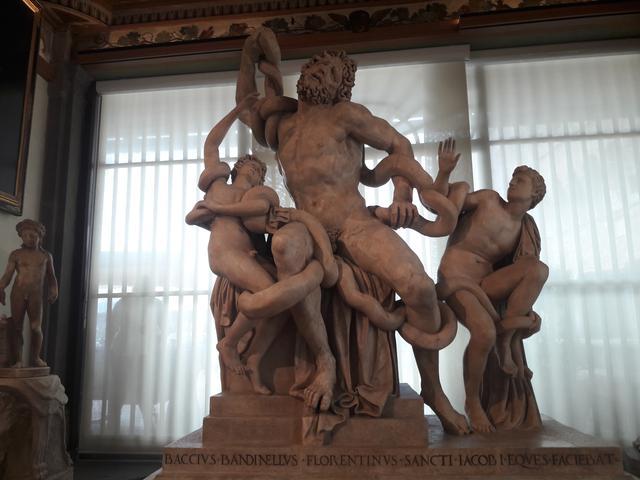Laocoön and his sons

The monumental Laocoon Group, also called Laocoon and his sons, by Baccio Bandinelli (Firenze 1493-1560) - from the Hellenistic original brought to light in Rome on January 14, 1506 in the vineyard of Felice de Fredis, near Titus Thermae in Opium Hill: represents the Trojan priest Laocoon and his two sons trapped in the works of the sea serpents sent by Poseidon. In the original, which as recorded by Pliny the Elder in his Historia Naturalis had been made from a single block of marble, the priest's right arm was missing, and Vasari's Life of Baccio Bandinelli tells us that he made an arm in wax to He replaced the lost one and used it as a model for his copy of the Laocoon, commissioned in 1520 by Pope Leo X de' Medici as a gift to King Francis I. Baccio made his copy from three blocks of marble. He decorated the front of the pedestal with a naturalistic open scroll with folding lines, and the sides with the emblem of Pope Clement VII: a transparent globe pierced by a ray of sunlight that sets fire to a tree, and the pope's motto "Candor illaesus." .
Upon the death of Pope Leo X, the commission was suspended, and the sculpture resumed work in 1523 after Giulio de'Medici was elected Pope Clement VII. In 1525, the group was complete, and the Pope was so enthusiastic about the result that he decided to send it to Florence, to the Medici Palace where Vasari saw it at the end of the second corridor. It was later transferred to the Casino di San Marco and landed in the Gallery with the inheritance of Cardinal Carlo de' Medici, probably in 1671.
A previous restoration was carried out after the sculpture was severely damaged by the fire that devastated the Gallery on August 12, 1762, causing the roof over the western corridor to partially collapse, and the Laocoon characters to be broken. in more than forty parts. Over the decades, the surface had become opaque and darkened by layers of dust and wax, which, if on the one hand hid the old putty and integrations, and the irreversible red stains caused by fire, on the other hand prevented proper legibility of the artwork.
© Tourblink